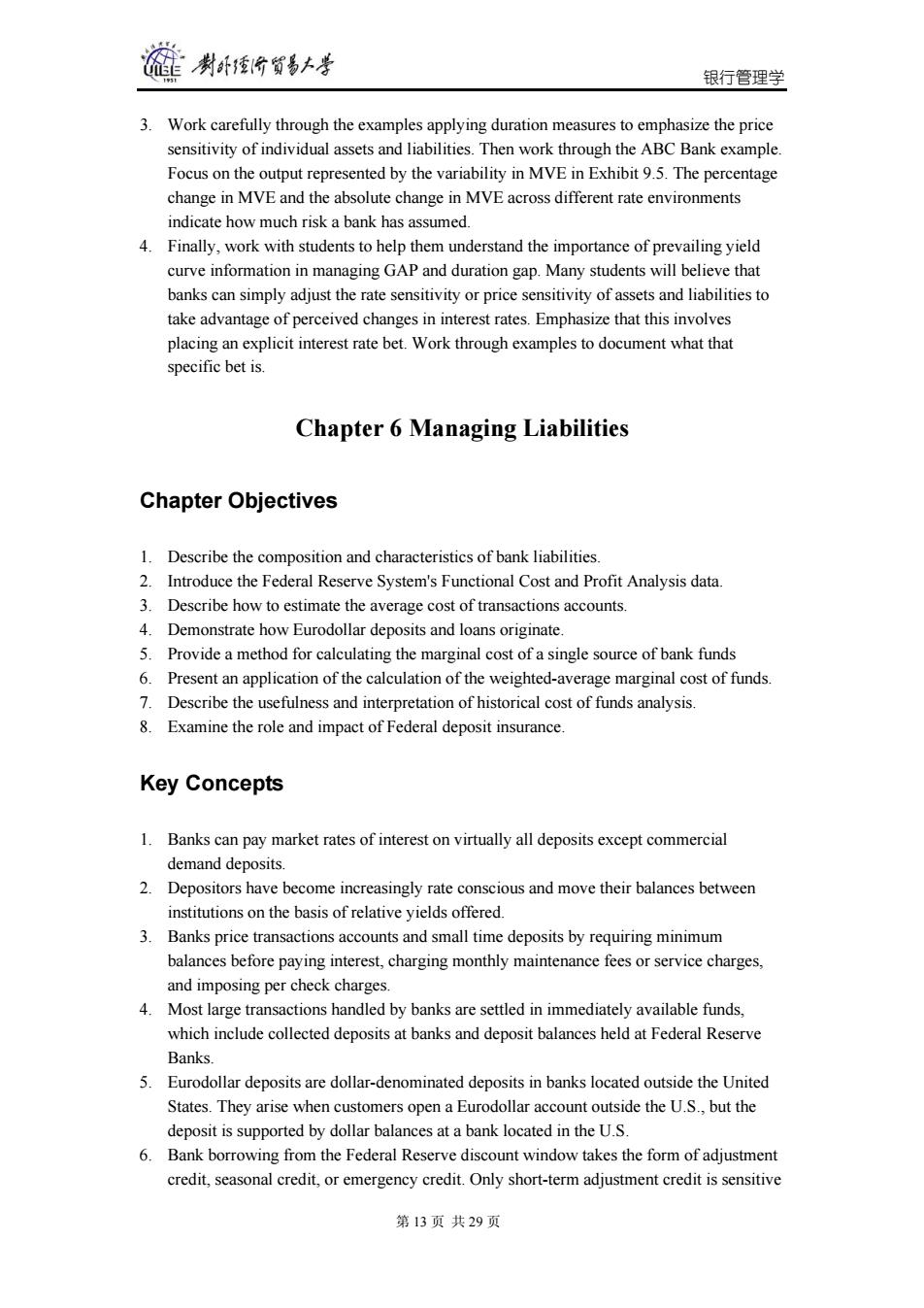正在加载图片...

制卧台贸易上考 银行管理学 3.Work carefully through the examples applying duration measures to emphasize the price sensitivity of individual assets and liabilities.Then work through the ABC Bank example. Focus on the output represented by the variability in MVE in Exhibit 9.5.The percentage change in MVE and the absolute change in MVE across different rate environments indicate how much risk a bank has assumed. 4.Finally,work with students to help them understand the importance of prevailing yield curve information in managing GAP and duration gap.Many students will believe that banks can simply adjust the rate sensitivity or price sensitivity of assets and liabilities to take advantage of perceived changes in interest rates.Emphasize that this involves placing an explicit interest rate bet.Work through examples to document what that specific bet is. Chapter 6 Managing Liabilities Chapter Objectives 1.Describe the composition and characteristics of bank liabilities. 2.Introduce the Federal Reserve System's Functional Cost and Profit Analysis data. 3.Describe how to estimate the average cost of transactions accounts. 4.Demonstrate how Eurodollar deposits and loans originate 5.Provide a method for calculating the marginal cost of a single source of bank funds 6.Present an application of the calculation of the weighted-average marginal cost of funds 7.Describe the usefulness and interpretation of historical cost of funds analysis. 8.Examine the role and impact of Federal deposit insurance Key Concepts 1.Banks can pay market rates of interest on virtually all deposits except commercial demand deposits. 2.Depositors have become increasingly rate conscious and move their balances between institutions on the basis of relative yields offered. 3.Banks price transactions accounts and small time deposits by requiring minimum balances before paying interest,charging monthly maintenance fees or service charges, and imposing per check charges. 4.Most large transactions handled by banks are settled in immediately available funds, which include collected deposits at banks and deposit balances held at Federal Reserve Banks. 5.Eurodollar deposits are dollar-denominated deposits in banks located outside the United States.They arise when customers open a Eurodollar account outside the U.S.,but the deposit is supported by dollar balances at a bank located in the U.S 6.Bank borrowing from the Federal Reserve discount window takes the form of adjustment credit,seasonal credit,or emergency credit.Only short-term adjustment credit is sensitive 第13页共29页银行管理学 第 13 页 共 29 页 3. Work carefully through the examples applying duration measures to emphasize the price sensitivity of individual assets and liabilities. Then work through the ABC Bank example. Focus on the output represented by the variability in MVE in Exhibit 9.5. The percentage change in MVE and the absolute change in MVE across different rate environments indicate how much risk a bank has assumed. 4. Finally, work with students to help them understand the importance of prevailing yield curve information in managing GAP and duration gap. Many students will believe that banks can simply adjust the rate sensitivity or price sensitivity of assets and liabilities to take advantage of perceived changes in interest rates. Emphasize that this involves placing an explicit interest rate bet. Work through examples to document what that specific bet is. Chapter 6 Managing Liabilities Chapter Objectives 1. Describe the composition and characteristics of bank liabilities. 2. Introduce the Federal Reserve System's Functional Cost and Profit Analysis data. 3. Describe how to estimate the average cost of transactions accounts. 4. Demonstrate how Eurodollar deposits and loans originate. 5. Provide a method for calculating the marginal cost of a single source of bank funds 6. Present an application of the calculation of the weighted-average marginal cost of funds. 7. Describe the usefulness and interpretation of historical cost of funds analysis. 8. Examine the role and impact of Federal deposit insurance. Key Concepts 1. Banks can pay market rates of interest on virtually all deposits except commercial demand deposits. 2. Depositors have become increasingly rate conscious and move their balances between institutions on the basis of relative yields offered. 3. Banks price transactions accounts and small time deposits by requiring minimum balances before paying interest, charging monthly maintenance fees or service charges, and imposing per check charges. 4. Most large transactions handled by banks are settled in immediately available funds, which include collected deposits at banks and deposit balances held at Federal Reserve Banks. 5. Eurodollar deposits are dollar-denominated deposits in banks located outside the United States. They arise when customers open a Eurodollar account outside the U.S., but the deposit is supported by dollar balances at a bank located in the U.S. 6. Bank borrowing from the Federal Reserve discount window takes the form of adjustment credit, seasonal credit, or emergency credit. Only short-term adjustment credit is sensitive